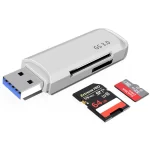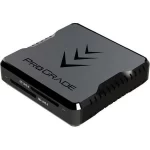When it comes to transferring data between your computer and various storage media, speed and reliability are paramount. This is where the Realtek USB 2.0 card reader steps in. A cornerstone of modern computing, this device has become an indispensable tool for both home and professional users. In this comprehensive guide, we will delve into the intricacies of the Realtek USB 2.0 card reader, exploring its features, benefits, compatibility, and troubleshooting tips.
What is a Realtek USB 2.0 Card Reader?
At its core, a Realtek USB 2.0 card reader is a peripheral device that enables you to connect various memory cards, such as SD, microSD, CompactFlash, and Memory Stick, to your computer via a USB 2.0 port. Realtek, a prominent semiconductor company, is renowned for producing high-quality chipsets, including those used in card readers. These devices bridge the gap between your digital camera, camcorder, or other storage device and your computer, allowing for seamless data transfer.
How Does a Realtek USB 2.0 Card Reader Work?
The functionality of a Realtek USB 2.0 card reader is relatively straightforward. When you insert a memory card into the reader, the device establishes a connection with the card and reads the data stored on it. This data is then transferred to your computer through the USB 2.0 interface. While the underlying technology may seem complex, the user experience is typically seamless and user-friendly.

Benefits of Using a Realtek USB 2.0 Card Reader
- Versatility: Most Realtek USB 2.0 card readers support a wide range of memory card formats, making them compatible with various digital devices.
- Speed: While USB 2.0 may not be the fastest transfer standard available, it still offers decent speeds for most users. This is particularly beneficial for transferring photos, videos, and other media files.
- Convenience: Card readers eliminate the need for additional cables and adapters, simplifying the data transfer process.
- Cost-effectiveness: Realtek USB 2.0 card readers are generally affordable, making them accessible to a wide range of users.
- Reliability: Realtek is known for producing reliable components, and card readers equipped with their chipsets often exhibit excellent performance and durability.
Compatibility and Limitations
While Realtek USB 2.0 card readers are compatible with a vast array of memory cards, it’s essential to check the specific supported formats before making a purchase. Some older card formats may not be supported by newer models. Additionally, while USB 2.0 offers reasonable transfer speeds, it may not be ideal for transferring large files or handling high-resolution video footage. In such cases, a USB 3.0 or Thunderbolt card reader might be a better option.
Choosing the Right Realtek USB 2.0 Card Reader
When selecting a Realtek USB 2.0 card reader, consider the following factors:
- Supported memory card formats: Ensure the reader supports the types of cards you use most frequently.
- Read and write speeds: If speed is a priority, look for models with higher performance ratings.
- Portability: If you need a card reader for on-the-go use, consider a compact and lightweight option.
- Additional features: Some card readers may offer additional features like card ejection buttons or LED indicators.

Troubleshooting Common Issues
Despite their reliability, Realtek USB 2.0 card readers can occasionally encounter problems. Here are some common issues and potential solutions:
- Card reader not detected: Check the USB connection, try a different port, and ensure the card reader has sufficient power.
- Card not recognized: Verify that the card is inserted correctly, clean the card contacts, and try a different card reader.
- Slow transfer speeds: Check the USB cable, try a different port, and consider the card’s read/write speed limitations.
- Data corruption: Use reputable software to scan and repair the card, and avoid removing the card while data is being accessed.
Common queries about Realtek USB 2.0 Card Reader
General Questions
- What is a Realtek USB 2.0 card reader?
- A Realtek USB 2.0 card reader is a device that allows you to connect memory cards (SD, microSD, CompactFlash, etc.) to your computer for data transfer. Realtek is the company that provides the chipset for these card readers.
- How does a Realtek USB 2.0 card reader work?
- When you insert a memory card into the reader, it establishes a connection and reads the data. This data is then transferred to your computer via the USB 2.0 interface.
- What are the benefits of using a Realtek USB 2.0 card reader?
- Versatility, speed, convenience, cost-effectiveness, and reliability are the primary benefits.
- Is a Realtek USB 2.0 card reader compatible with all memory cards?
- While most support a wide range of formats, it’s essential to check the specific compatibility before purchasing.
Compatibility and Performance
- What memory card formats are compatible with Realtek USB 2.0 card readers?
- Common formats include SD, microSD, CompactFlash, and Memory Stick. However, specific compatibility varies by model.
- How fast are Realtek USB 2.0 card readers?
- USB 2.0 offers decent speeds for most users, but it may not be ideal for large files or high-resolution videos.
- Can I use a Realtek USB 2.0 card reader with a USB 3.0 port?
- Yes, it’s backward compatible. However, you won’t get the full speed benefits of USB 3.0.
Troubleshooting
- My computer doesn’t recognize the card reader. What should I do?
- Check the USB connection, try a different port, and ensure the card reader has sufficient power.
- The card reader doesn’t recognize my memory card. What can I do?
- Verify correct insertion, clean the card contacts, and try a different card reader.
- Data transfer is slow. How can I improve speed?
- Check the USB cable, try a different port, and consider the card’s read/write speed limitations.
Purchasing and Usage
- How do I choose the right Realtek USB 2.0 card reader?
- Consider supported memory card formats, read/write speeds, portability, and additional features.
- Can I use a card reader to transfer files between two computers?
- No, card readers are primarily for transferring data between a memory card and a computer.
By addressing these common queries, you can provide valuable information to users seeking to understand and utilize Realtek USB 2.0 card readers effectively.
Troubleshooting tips and solutions
| Issue | Troubleshooting Tips |
|---|---|
| Card reader not detected | * Check the USB connection: Ensure the cable is securely plugged into both the card reader and your computer’s USB port. <br> * Try a different USB port: Sometimes, a specific port may malfunction. Try connecting the card reader to another available port. <br> * Ensure sufficient power: If the card reader requires external power, verify that it’s properly connected and functioning. |
| Card not recognized | * Verify card insertion: Make sure the card is inserted correctly according to the reader’s slot orientation. <br> * Clean card contacts: Gently clean the metal contacts on the card with a soft, dry cloth to remove any dust or debris. <br> * Try a different card reader: If the issue persists, using a different card reader can help isolate whether the problem lies with the card or the original reader. |
| Slow transfer speeds | * Check the USB cable: A damaged or low-quality cable can hinder transfer speeds. Consider using a high-speed USB cable. <br> * Try a different USB port: Similar to the previous tip, a different port might offer better performance. <br> * Consider card limitations: The card itself may have inherent speed limitations. Check the card’s specifications for its read/write speeds. |

The Realtek USB 2.0 card reader remains a valuable tool for many users, offering a convenient and affordable way to transfer data between memory cards and computers. While newer technologies like USB 3.0 and Thunderbolt have emerged, USB 2.0 continues to provide reliable performance for a wide range of applications. By understanding the features, benefits, and potential limitations of Realtek USB 2.0 card readers, you can make an informed decision and optimize your data transfer experience.


